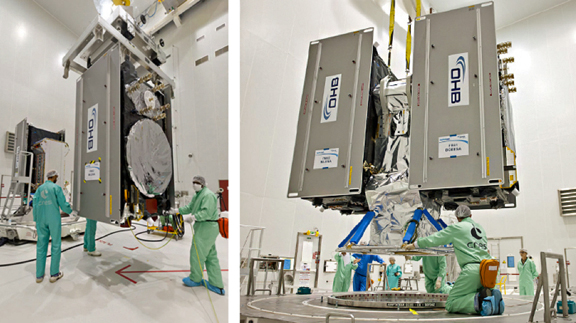
[SatNews] “Doresa” and “Milena” have met for the first time, paving the way for their upcoming role in advancing the European Galileo space-based navigation system.

The Galileo FOC (Full Operational Capability) satellite named “Milena” is mated on its Soyuz dispenser unit, joining the already-installed “Doresa” satellite (left photo). At right, the completed dispenser unit is ready to be transferred from the S5 payload preparation facility at the Spaceport in French Guiana for its integration atop Soyuz’ Fregat upper stage.
Photos are courtesy of Arianespace.
The join-up of Doresa and Milena—Europe’s first two FOC (Full Operational Capability) satellites for the Galileo constellation—occurred at the Spaceport in French Guiana. These 730kg. satellites are named for children who were among those winning a 2011 painting competition, and the platforms will be orbited by Arianespace during a mission scheduled for the morning of August 21. Doresa and Milena were mounted on a two-sided dispenser system during integration activity in the Spaceport’s S5 payload preparation facility, readying them for the subsequent installation on Soyuz’ Fregat upper stage and their encapsulation in a protective payload fairing. These steps will create the “upper composite” section that is to be installed on Soyuz once the vehicle is moved to its Spaceport launch zone.
The two FOC satellites, along with those to follow on future Arianespace launches, will create a European-operated space-based navigation system providing highly accurate, guaranteed global positioning services. Galileo’s FOC phase is being funded and executed by the European Union, which has designated the European Space Agency as the system’s development and sourcing agent. OHB System built the Doresa and Milena satellites in Bremen, Germany as prime contractor. Their payloads, which will generate the precision positioning measurements and services to users worldwide, were supplied by Surrey Satellite Technology Ltd. in Guildford, UK.
Arianespace’s August 21st mission is designated Flight VS09 in the company’s launcher family numbering process, and will be its latest in support of Galileo’s overall system development. The process began by lofting two GIOVE (Galileo In-Orbit Validation Element) satellites in December 2005 and April 2008 on Soyuz missions operated by Arianespace’s Starsem affiliate from Baikonur Cosmodrome in Kazakhstan. This was followed by four Galileo satellites used for the system’s In-Orbit Validation (IOV) phase, launched in pairs on Soyuz flights performed by Arianespace from French Guiana in October 2011 and October 2012. These four IOV spacecraft enabled testing of the full Galileo system, clearing the way for the FOC phase.
Europe’s complete Galileo constellation is to be composed of 27 operational satellites and three reserves, distributed along three circular medium Earth orbit planes at an altitude of 23,222 km., inclined 56 deg. to the equator. Galileo will become another cornerstone in global satellite navigation, as it is interoperable with the existing U.S. GPS and Russian Glonass navigation systems.
Follow Arianespace's launch activity at: http://www.arianespace.com/.

